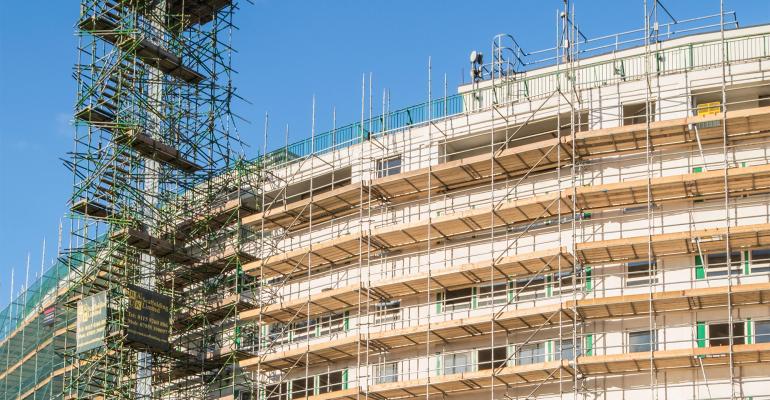Some of the biggest names in the multifamily sector are celebrating flashy new redevelopments that transformed old office towers into gleaming, luxury apartments. But difficult floorplates, zoning regulations and expensive redevelopment costs all make it difficult for a wider push of office-to-multifamily conversions.
Brookfield Properties is charging market high rents for the over 700 apartments and penthouses at the four communities of Mercantile Place in Downtown Dallas, located between a Neiman Marcus flagship store and the new Main Street Park.
Redevelopments like this can give new life to office buildings that are no longer profitable—especially as many companies need less space for employees who are still happy to work from home.
In another recent example, American Real Estate Partners (AREP) acquired an office site in Alexandria, Va.’s Old Town district that it will redevelop into 200 apartments with 17,500 sq. ft. of retail and office space on the first floor.
According to AREP, “The acquisition included the simultaneous purchase of all condominium units in the office building from the seven owners. All office leases were restructured to allow for a deconversion of the office condominium and redevelopment into a mixed-use property.”
“This office to multifamily conversion acquisition is one of our core investment strategies and reinforces our ability to identify strong investments across diversified product types and markets to deliver value,” AREP Co-Founder and President Brian Katz said in a statement.
More offices being redeveloped
There has been a steady escalation of office-to-apartment conversions in recent years. Developers finished more than 7,000 new apartments in 2021 in renovated former office buildings, according to data from Yardi Matrix. That’s the largest number in recent years, topping the nearly 6,000 in 2020. From 2013 through 2019, developers averaged about 4,000 new apartments a year in old office buildings. Before 2013, developers rarely completed more than 1,000 a year, according to Yardi Matrix.
More office building are being redeveloped as older buildings become obsolete. New office developments like Hudson Yards in Manhattan offer faster Internet connectivity, improved indoor air quality and more natural light. Many older, office buildings can’t compete as the companies that rent space in them need fewer square feet—many employees still spend at least part of the week working from home in the aftermath of the coronavirus pandemic.
"Older assets without modern features have struggled, especially in urban cores," says Alan Pontius, senior vice president and national director of the Marcus & Millichap’s office, industrial, and healthcare divisions. New office spaces, which often meets recent elevated benchmarks for both environmental and health and safety criteria, could earn rent premiums of up to 20 percent compared to older, unrenovated office space, Pontius says.
At the same time, demand for apartments has rebounded strongly in many of downtowns.
Office conversions are hard to pull off
New apartments created in old office buildings are still just a tiny fraction of the new apartments finished every year—more than 300,000 in 2021, according to Census data.
“The key issue people do not understand is just how difficult and expensive these conversions can be,” says Jim Costello, chief economist at MSCI-Real Estate.
Office buildings often have large floorplates. Much of the space is far from a window, limiting how many bedrooms can fit on each floor. Developers struggle to find uses, like storage units, that can make use of windowless space.
“These projects are so few that it’s hard to generalize the trends,” says Jay Parsons, head of economics and industry principals for RealPage, based in Richardson, Texas. “There’s so much more buzz about it than there are actual real-life office-to-apartment conversions.”
Redevelopers may also find surprises in the walls that don’t match the original building plans, from asbestos and lead paint to forgotten fuel tanks.
A building that is still profitable as office space is unlikely to be redeveloped. "The only assets that should be viable to convert are those with low occupancy, yet that still have inherent land value," says Costello.
However, once a building has failed as office space, local officials may be eager to help it find new life as redeveloped apartments. For example, former New York Governor Andrew Cuomo called for a change in regulations to permit commercial property owners to convert their buildings to residential uses in his State of the State address in 2021. Other cities, like Pittsburgh, have dedicated millions to help pay to redevelop commercial space to become apartments. Buildings that are historic landmark buildings can also receive historic rehabilitation tax credits from the federal government and many states.
“The sites that work are not specific to certain markets, it’s more about having the right type of building floorplate and tax incentivizes (like historical preservation) that help make these deals pencil out,” says Parsons.

